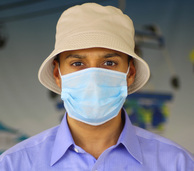Breakfast in Guangzhou (Shiqiao)No tea or coffee today...sometimes I can be VERY Chinese in my approach to lifestyle. A glassfull of fresh cold milk (taken from well fed local Chinese cows in Guangzhou!), and a couple of delicious Cantonese Egg Tarts did the trick. Lunch in the air (somewhere over Shaoguan, Guangdong)Afternoon Tea at the Shangri-La, Pudong (Shanghai)Shanghai is romantic, hectic, elegant, and nothing short of standing by it motto of being 'The Paris of the East'. From the Jade 36 bar atop the Shangri-La Pudong hotel, under July’s leaden skies; the futuristic skyline of Pudong contrasts with the elegant old-world style of The Bund on the Shanghai side. Go and see it as soon as you can...and enjoy the Afternoon-Tea at the Shangri-La, Pudong.
Panyu attracts a lot of 'Fortune Tellers' (you may read this). It remarkably seems to be a very competitive business for them. It's not uncommon to come across around 10 guys sitting next to each other waiting to tell stories! In my opinion, horoscopes are great when they say nice things about you:
"Leixinge (my Chinese name), you are caring and kind. Highly intelligent. Likes to be the center of attention. Very organized. High appeal to opposite sex. Likes to have the last word. Good to find, but hard to keep. Passionate, wonderful lover. Fun to be around. Thoughtful. Loves to joke, but lets some people down due to misunderstandings. Too trusting at times and gets hurt easily. You always try to do the right thing and sometimes get the short end of the stick. You sometimes get used by others and get hurt because of their trusting. Extremely weird but in a good way- sometimes talks too much. Good sense of humor!! Very popular. Silly, fun, and cute. Good friend to others but needs to be choosy on who they allow their friends to be." But, not to worry...they never mention any bad news or bad stuff...it's always good news. I wish I had taken a photo of Panyu back on that hot summer's day in August 2003. This is because if I had taken a photo of Panyu all those years ago then I would have been able to compare to what it looked like in those days to what it looks like today. In those days Panyu was nothing but a dusty industrial town with very poor infrastructure, and was heavy polluted. Since the opening of metro Line 3 in 2009, two of Panyu's sub districts - Panyu Square and Shiqiao - have become heavily popular residential areas for most of Guangzhou's population. Rent is still remarkably cheaper than what you would have to pay in downtown Tian He (a three bedroom modern apartment can cost anything in the region of RMB 3,000 in Panyu...the same apartment would cost around RMB 7,800 in downtown).
Shiqiao, an area covering only 11.35 square kms is becoming modern at a dizzying pace (I would refrain from saying that it's becoming more Americanized like the rest of the country). In the space of around 3 years this tiny town with a population of around 280,000 in the south-east of Panyu district, has become home to SIX McDonald's outlets, TWO KFC outlets, TWO Starbucks outlets (as if one was not enough), TWO Pizza Hut outlets, and an abundance of 7-Eleven stores. Shiqiao is the political, economic, cultural and commercial centre of Panyu District, and has direct jurisdiction over 28 communities and 8 villages. Oh, by the way, there used to be a Dunkin Donuts outlet in the main plaza next to Shiqiao Metro station. It opened in 2009 when I first started living in Shiqiao, and then it closed in February this year due to lack of demand because Chinese people love Starbucks (it's seen as a status symbol among the rising Middle-Class and elite to drink Starbucks coffee). I am a huge fan of Dunkin Donuts, and being British, I have always been highly impressed by the way they make their milk teas- now that's something rare for an American food outlet to achieve (!). I would be more than happy to speak to a few Starbucks executives about this, but in my opinion Starbucks are not marketing and selling the tea as it should be done (take note....Earl Grey is tea without flavour...and I'd like to meet the innovative person who thought about serving a cup of tea with milk FOAM poured on the top!!). I have bought Starbucks tea in mainland China, Dubai, Istanbul, Singapore, Bangkok, Detroit, Toronto, Paris, Hong Kong, and even in London (home of tea!), and I can tell you that it tastes nothing like the tea that we loyal tea drinkers are used to. I am not sure what native Indians in India think about the tea offered by Starbucks. Believe me, being a British man of Indian heritage I know what real tea and coffee tastes like (I am, of course, referring to black tea). Chai, the word for tea used in most Eurasian countries (including Russia), originated in India during the British Raj under King George, and the original tea derives from the romantic hills of Darjeeling and Shimla (PG Tips and Tetley have it right). Maybe Starbucks should stick to just selling the coffee - which by my definition is not real coffee either. In my opinion, Chinese people need to be brought up to revere real Italian coffee. Perhaps they should do what the Aussies did after the GFC, where 800 Starbucks stores were closed in Australia - mostly in Melbourne. Only poofs put vanilla in coffee, and milk foam on their tea...! The Durian is commonly known as the 'King of the fruits', and is the only fruit that is banned on-board aircraft, and on the subway in Singapore (because it has a horrible odour). Its not as bad tasting as it looks and smells. Mostly found in South-East Asia. People in China love the Durian and use it as a vital ingredient for desserts.
With so much local culture to explore in Guangdong province, I decided to take a day’s trip down to Panyu, the oldest part of Guangzhou located in the south part of the metropolis. This town was the original capital city of Guangdong province. I decided to check out the tiny village of Shawan, the part of the city that formed the epicentre of that original capital city. Located around 6 kilometres from the nearest metro station at Shiqiao, Shawan village is neatly hidden away in the outskirts of the city.
Though the village is trying to attract tourists, it still resembles somewhat of a ghost town as there is hardly a whisker in sight on any given day of the week (except of course during the holiday season). On any average hot summer’s day it is normal to walk through the quite narrow lanes of the village and perhaps come across shop keepers lazily taking an afternoon siesta in the shade away from the blazing midday sun. The village does not possess the charm that may be found in more well known ancient preserved villages such as for example Suzhou or Hangzhou. What is amazing is that people live in Shawan in a similar style and in a similar style of environment as they used to do hundreds of years ago. The only difference may be that nowadays people have electricity, proper sanitation, internet, and most important of all, air-conditioning to take respite away from the hot and humid weather. However, other ways of living are similar to traditional style of living like milking the cows by hand, hens, and rabbits freely flocking the grounds, butchers having their meat being sold on ice-carts, and bread rolls, and seeds being dried using the baking sun’s heat. And in between these people’s homes, large former mansions belonging to Emperors and former ancient government ministers have been converted into museums for all to see. It just goes to show the lavish life they had in those days. Try indulging your taste buds into the local delicacy, sweet milk curd (known locally as ‘Shuang Pi Nai’). Every morning cows are milked in the farms nearby. The ridiculously delicious milk is then blended in with sugar, and served either hot or cold. It tastes a bit like lemon curd, or fresh Greek style yogurt, but not as thick in texture. The temptation to have more than one cupful is difficult to resist. Each cupful costs RMB 5 (around GBP 50 pence). Allow a good 1 hour to explore the place. It may feel isolated at first, but I tell you, looks can be deceptive. Shawan has more jewels to offer than the eye meets at first glance. Just make sure you take your camera with you, and be ready to capture the unusual. How I got to Shawan: If you are coming from downtown Guangzhou, then take metro line 3 to Shiqiao station and then take exit C. As you come out of the metro station exit C, turn left in front of Seven 11. After Seven 11, turn right, and you will come across a branch of Pizza Hut. Right in front of Pizza Hut is a bus stop from where you can take bus number 12 straight to Shawan. The cost is RMB 2 one way, and takes around 20 minutes. After you get off the bus stop at Shawan then walk straight ahead for around 30 feet until you come across a large cinema complex, and then turn right. Shawan Ancient Town is straight ahead of you! How much does it cost? Visitors can purchase a RMB55 that allows you entrance to all the 10 preserved mansions and small museums, or there is a separate RMB10 charge for each attraction (i.e. it makes sense to purchase the RMB 55 collective ticket as you get more for low price). I fondly recall taking part in the dragon boat race this time last year in Shanghai, of which our super team was beaten into 2nd place by less than only 2 seconds! As captain, I was gifted with a superb team who excelled in all departments of organization, structure, and perfect motion of the oars with great timing. A fantastic team, along with perfect weather conditions helped us to become (almost) winners of the tournament. This year, though I will not be taking part in any dragon boat race, I will, however be watching a few races at the Zhujiang River (Pearl River) in Guangzhou. The Dragon Boat Festival is a lunar holiday, occurring on the fifth day of the fifth lunar month. The Chinese Dragon Boat Festival is a significant holiday celebrated in China, and the one with the longest history. The Dragon Boat Festival is celebrated by boat races in the shape of dragons. Competing teams row their boats forward to a drumbeat racing to reach the finish end first. The boat races during the Dragon Boat Festival are traditional customs to attempts to rescue the loyal Chinese poet Chu Yuan. Chu Yuan drowned on the fifth day of the fifth lunar month in 277 B.C. Chinese citizens now throw bamboo leaves filled with cooked rice into the water. Therefore the fish could eat the rice rather than the hero poet. This later on turned into the custom of eating tzungtzu, and rice dumplings (known as 'zhongzhi'). Chinese people normally have 3 days off work. So this year the 22nd, 23rd and 24th will be national holidays for all mainland Chinese people. In Guangzhou, a race was organized in the Lizhiwan area of the city. Lizhiwan looks rather like Guangzhou’s equivalent of Amsterdam with boats navigating through the 743 meter-long waterway from Shamian Island to Liwan Lake. With lush greenery, numerous shops selling all kinds of traditional Cantonese food and period style buildings there is no better way to spend your day off. The one thing that does catch ones eye is the sensational ancient buildings with colonial style architecture that lie right next to rather traditional Cantonese architectural styled buildings. There is the amazing Wen Tower, a hexagonal designed pagoda style tower that gives a glimpse of the old style buildings. While in contrast there is the Chen Lianbo Residence, a typical Canton building from the 1920s colonial era. Some people also pay a visit to their local temple to pay respects to Buddha or Guangyi. The celebration is a time for protection from evil and disease for the rest of the year. It is done so by different practices such as hanging healthy herbs on the front door, drinking nutritious concoctions, and displaying portraits of evil's nemesis, Chung Kuei. Now, supposedly, if one manages to stand an egg on its end at exactly 12:00 noon, the following year will be a lucky one. Maybe I will try to do that this year and see if the following year will bring me good luck. On the other hand, no matter what, everyday is blessing from god. I had heard about Xiaozhou, a small village on the outskirts of Guangzhou city in Southern China, as being a popular re-treat for artists and poets. I was told that its quite, beautiful and clean. However, I am sorry to say, but I was rather disappointed when I finally got there. It was quite and beautiful- but certainly not clean (especially the river which seems never to have been cleaned- and gives off a horrible stench). The tourist map in my Hotel (The China Hotel by Marriott in Guangzhou) recommends its guests to visit this village, provided they have seen all the other tourist attractions in the city. Xiaozhou Village features classical Cantonese community landscapes by water, including canals, well-kept ancient buildings, bridges and local folkways. The only major disappointment with Xiaozhou is that the river is not clean and gives off a horrible stench. So if someone comes to Xiaozhou in search of a beautiful river, they will be let down. Other than this, it is worth visiting. Don’t get me wrong- Xiaozhou Village is not a museum, or an official tourist attraction, but people actually live there. Most of the residents are elderly folk who have maintained their ways of living for centuries. It’s almost as if time has stopped in Xiaozhou. While the rest of Guangzhou has moved on at a rapid pace, life in Xiaozhou is slow, and has a somewhat routine to it. Xiaozhou is a small and close-knit community. Everyone knows each other, and gossip travels fast amongst the old folk. Being a small and quite village also means that you can hear people arguing or shouting in another part of the neighbourhood. For example you may be in one part of the village and can still hear someone practicing Cantonese Opera loudly in another household!! If you ever want to taste what living in China must have been like, say, in the 1980s, then take a short trip to Xiaozhou! I took Line 3 Metro to Kecun station, and then bus 252 to Xiaozhou (it is 11 stops to Xiaozhou Village from Kecun, and costs 2RMB). The hour long bus journey from Kecun station to Xiaozhou village snakes its way between some of the most deprived areas of Guangzhou. Most people who got onto the bus at some of the stops on the way would look at me in curiosity as they most probably have never come across a non-Chinese person before. It just makes you wonder about the stark contrast between the high rise life of the city centre and the village life on the outskirts, where a family of four can survive on a salary of around 200RMB a month (compare this with a average monthly salary of around 4000RMB for a white collar worker).
|
Get in Touch:LIFE MATTERSHere I share my thoughts
and experiences during my travels, and how some things have affected my life as an expat and world traveller. Travelling is about capturing that moment in life. Every word, view and opinion on this page is that of Navjot Singh - except where indicated. The most recent is at the top. Scroll down to read the archive. Or search using CTRL+F (COMMAND + F) and enter a keyword to search the page. Just some of the stories you never heard before. The NAVJOT-SINGH.COM web blog is separate to this web site....Click blog, which may not be visible in some countries due to local firewall restrictions, so in those cases this weblog may be read. The weblog also includes some of my press trip reports- most of which are not published on the official blog because of copyright issues. The weblog also contains articles that may be associated directly with a PR trip for a country, airline or a hotel. These are PR reviews done in relations with various companies. If you are an investor or a trend watcher then you may find this website useful as investing has a lot to do with personal observations and finding the ideal trend or next big thing. The average human on the street frequently knows far more about the state of the economy than politicians, university professors, subject matter experts, and financial analysts who seldom travel, or if they do so, only from one hotel to another hotel! The pulse and vibrancy of an economy is nowhere more visible than on a country's streets. All photos and words are © Navjot Singh unless stated. Photos taken by others or by agencies are appropriately copyrighted under the respective name. No photo or word/s may be taken without the prior written permission by the author (i.e. Navjot Singh). All Rights Reserved. Archives
April 2024
Categories
All
|























































 RSS Feed
RSS Feed







